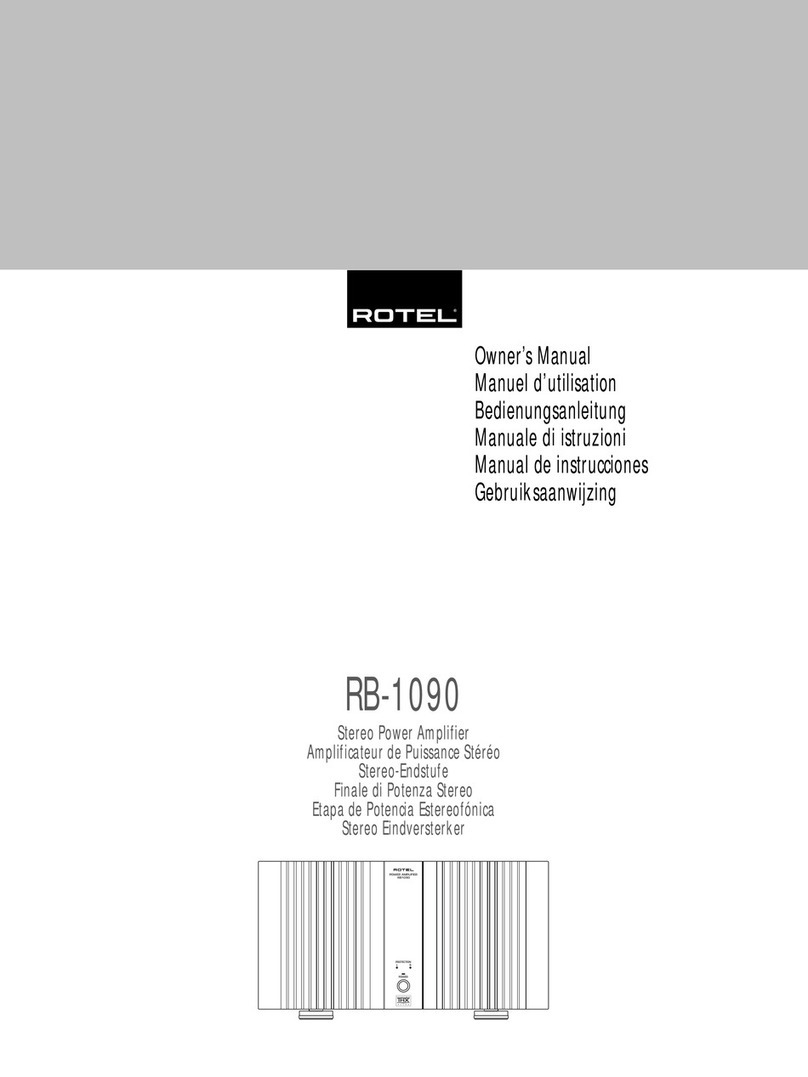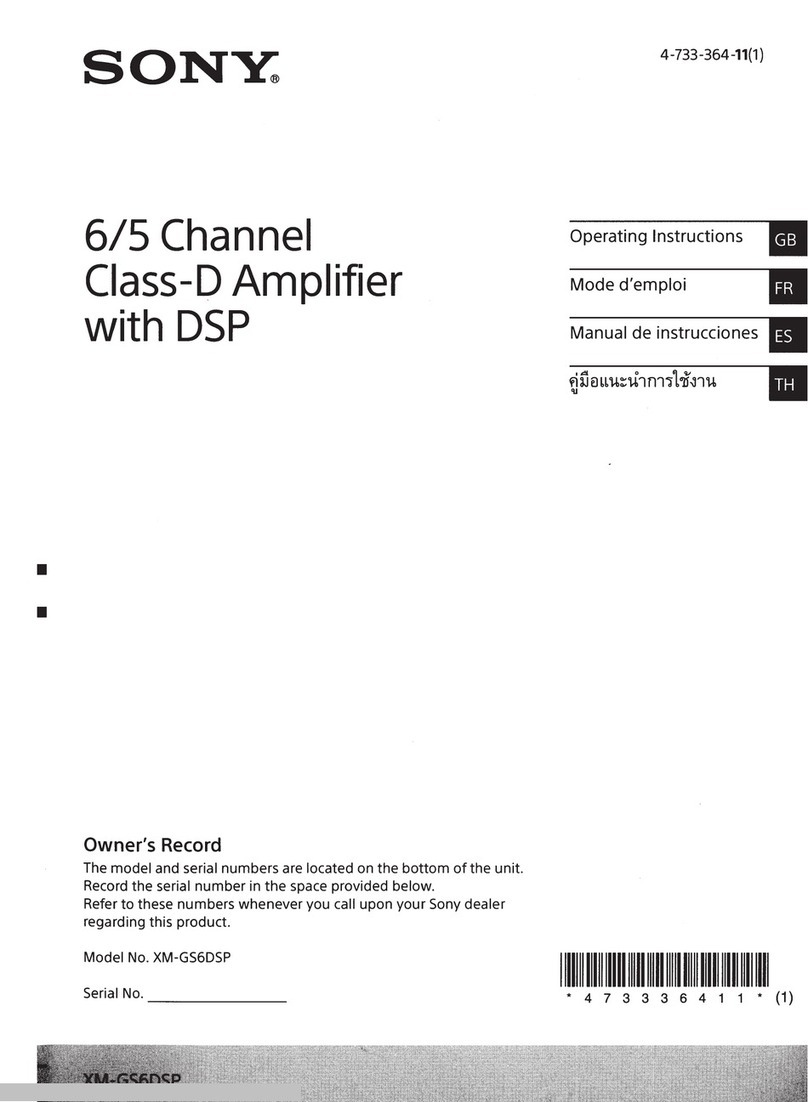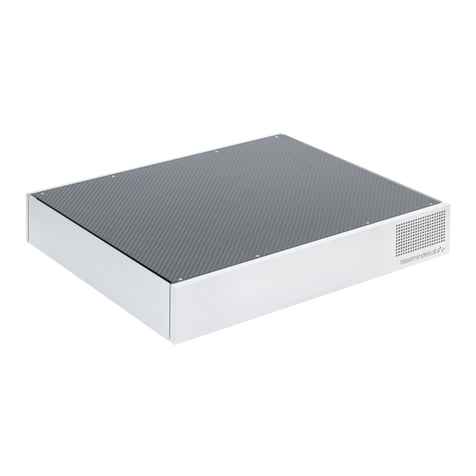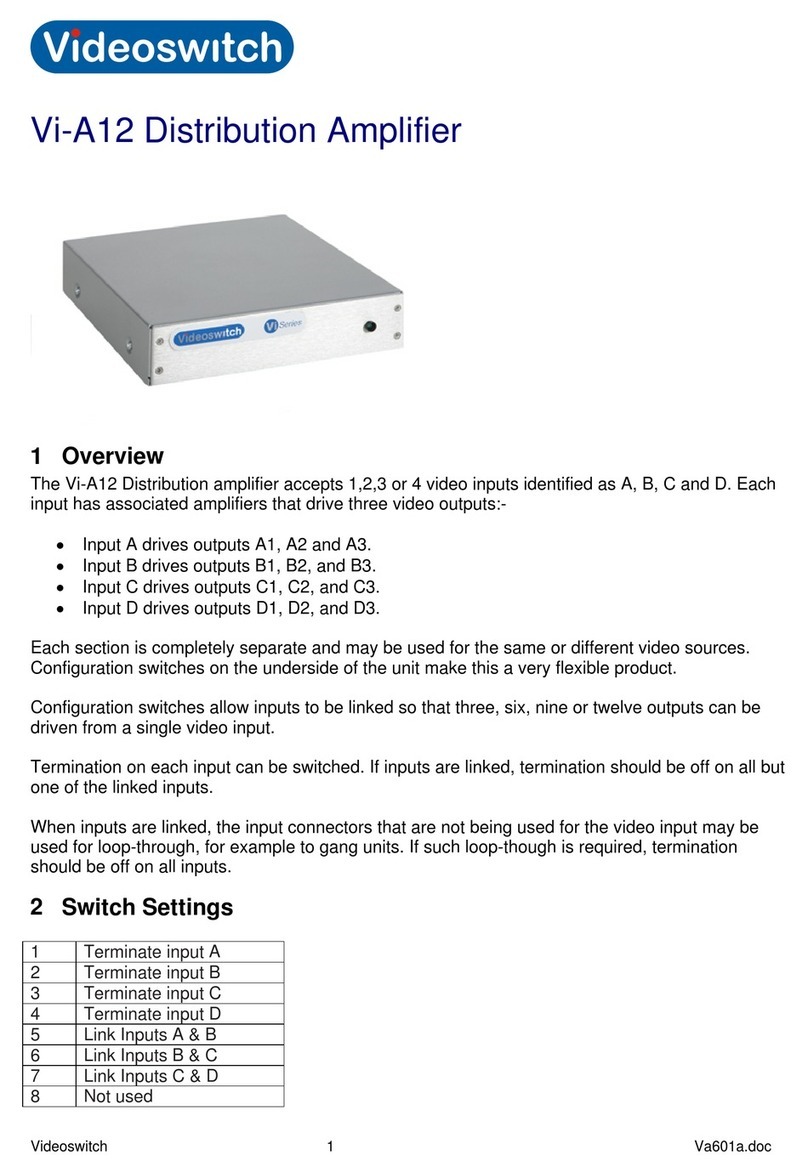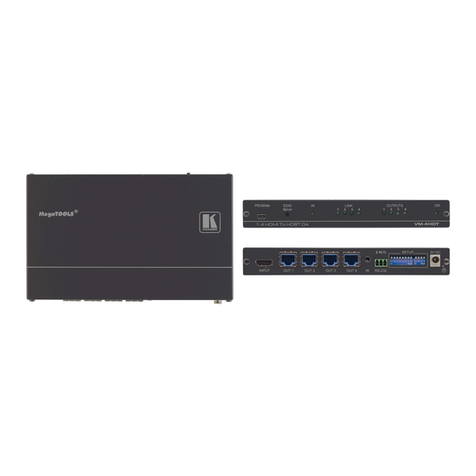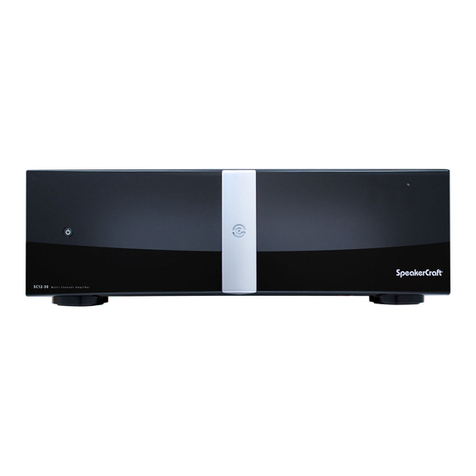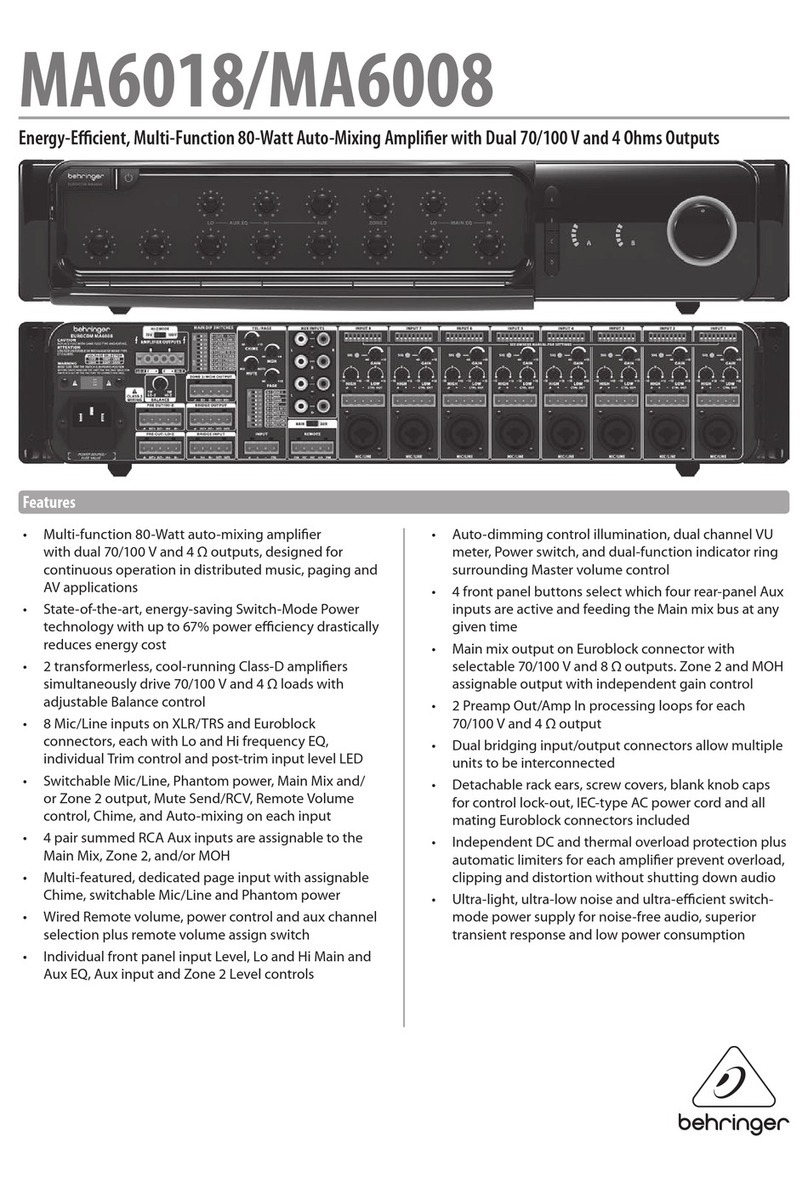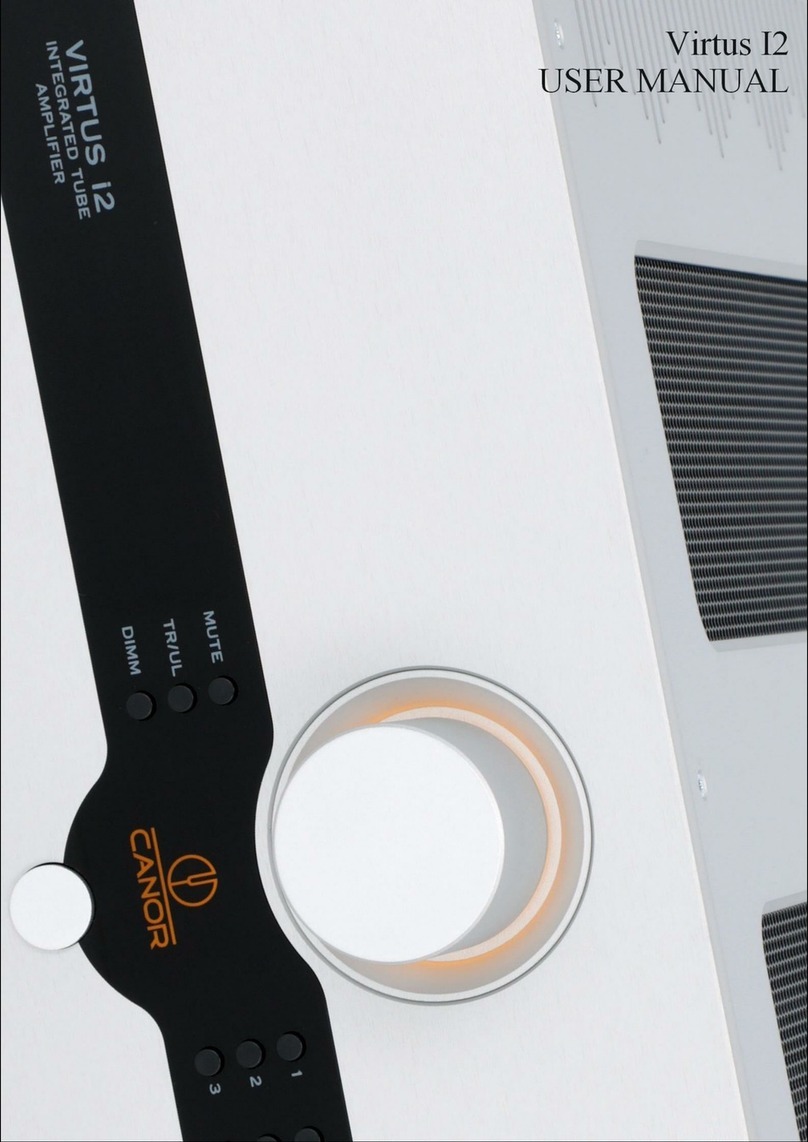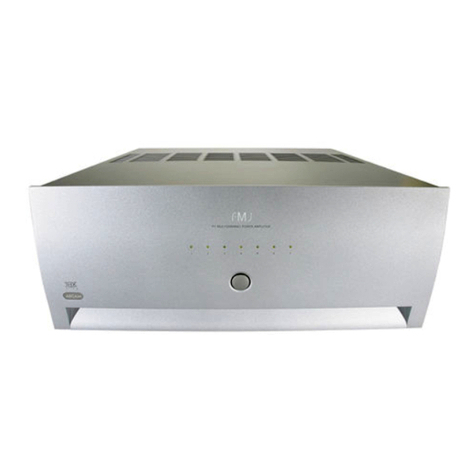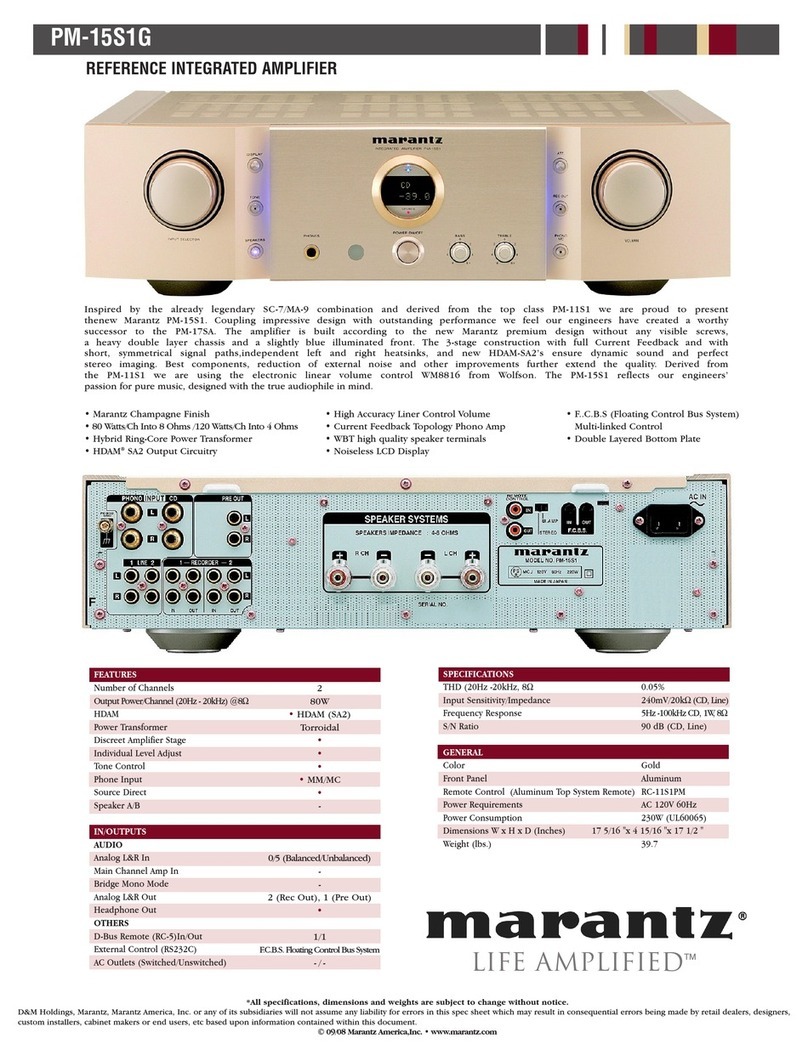Tucker-Davis Technologies PZ3 User manual

7-65
PZ3 Low Impedance Amplifier
PZ3LowImpedanceAmplifier
PZ3Overview
The PZ3 is a high channel count, low
impedance amplifier well suited for ECOG,
Evoked Potentials, EEGs, LFP’s, EMGs, and
other similar recording applications. Available in
32, 64, and 128 channel models, the PZ3
amplifier offers shared or true differential
operation, low input referred noise, impedance
checking, and an optional high input range
mode.
SystemHardware
A standard configuration for low sample rate,
low impedance recordings includes 1.5 mm
TouchProof connectors for electrodes, a PZ3
amplifier, and an RZ2 base station.
The battery powered PZ3 digitizes and amplifies
signals recorded from each of the electrode
channels. All digitized signals are sent via a
single fiber optic connection to the RZ2 base
station for further processing. The RZ2 also sends amplifier configuration information
to the PZ3 across the fiber optics.
The diagram below illustrates this flow of data and control information through the
system.
PZ3DataandControlFlowDiagram

7-66 System 3
PZ3 Low Impedance Amplifier
RecordingModes
The PZ3 supports two recording modes: Individual Differential and Shared Differential.
For Individual Differential (true differential) operation, the amplifier inputs are
grouped into banks of eight recording (+) channels, each with a paired alternate
indifferent (-) channel (inverting channel).
Individual(True)Differential,Bank1and2FunctionalDiagram
For Shared Differential operation, each bank of channels uses a separate shared
reference.
SharedDifferential,Bank1and2FunctionalDiagram
The PZ3’s impedance checking and a high voltage range features can be used in
both true and shared differential modes.
It is also important to note that in the various modes of operation, the RZ2
processor may use the alternate channels to report information such as impedance
values or RMS. This occurs at the software level on the RZ2. For example, in
Shared Differential mode the RZ2 maps RMS levels for each channel to the alternate
channels.
ElectrodeConnectors
The PZ3 is designed to record from low impedance electrodes and electrode caps
with input impedance less than 20 kOhm. Signals are input via multiple DB26

System 3 7-67
PZ3 Low Impedance Amplifier
connectors on the PZ3 back panel. A break out box or connector(s) are required
for electrode connection.
TDT provides a version of our LI-CONN connector for the PZ3: the LI-CONN-Z for
Shared Differential mode. It features standard 1.5 mm safety connectors and provides
easy connections between electrodes and the amplifier.
HardwareSet‐up
The diagram below illustrates the connections necessary for PZ3 amplifier operation.
One or more male connectors (such as the LI-CONN-Z) can be connected to the
input connectors on the PZ3 back panel. Alternately, custom connectors and a
breakout box can be used. If using custom connectors, see “Input Connectors” on
page 7-76 for pinout.
Note: In Shared Differential mode no connection should be made to the indifferrent (-)
channels.
A 5 meter paired fiber optic cable is included to connect the preamp to the base
station. The connectors are color coded and keyed to ensure proper connections.
The PZ3 battery charger connects to the round female connector located on the back
panel of the PZ3 amplifier.
Important! To avoid introducing EMF noise, DO NOT connect the charger to the PZ3 while
collecting data.
PZ3SoftwareControl
The amplifier’s mode of operation (shared or individual differential), other options,
and channel mapping tasks are handled using PZ3 specific macros within the
RPvdsEx control circuits running on the RZ2 Signal Processor.
RPvdsEx includes two PZ3 specific macros:
PZ3_Control macro
PZ3_ChanMap macro

7-68 System 3
PZ3 Low Impedance Amplifier
PZ3_ControlMacro
The PZ3 Control macro should be added to your RPvdsEx circuit to configure all
hardware features of the PZ3 amplifier.
Inputs are available on the macro for enabling/disabling the LED clip status lights,
enabling Impedance mode for electrode (+) channels, enabling Impedance mode for
alternate indifferent (-) channels, and dynamic power control for channel banks.
MacroOptions
Double-clicking the macro in RPvdsEx, displays the macro properties dialog box and
allows users to easily modify macro properties.
On the Options tab, in the properties dialog box:
Setting the Clip LEDs On to Yes or No enables or disables the LED clip warning
indicators.
Differential Mode allows the user to select from Shared Differential) or Individual
(True-Differential) modes.
Input Range may be set to either 3mV or 20mV input ranges.
The Target Impedance option allows the user to specify the impedance threshold
for the status LEDs for each channel bank. Three inputs are available on the macro
for enabling/disabling the LED clip status lights, enabling Impedance mode for
electrode (+) channels, and enabling Impedance mode for indifferent (-) channels.
Under the Power Control tab are additional options that specify how the PZ3
channel banks are powered.
PoweringDowntheChannelBanks
Channel banks may be powered down through the macro. As long as the
Power
Control Mode
under the Power Control tab is set to
Static
, channel banks may only
be powered up or down through the Power Control Mode options within the macro.
Dynamic mode will allow channel banks to be powered on or off either through both
the Power Control Mode options or by inputs on the macro through RPvdsEx
components. Each of the letter indexed channel banks in the macro correspond to 32
channels of the PZ3. Selecting
No
will enable a bank of channels while selecting
Yes
will power down and disable that bank of channels.
For Example:
If you are using a PZ3 with 128 channels, powering down Bank A (Select Yes)
would power down the first four blocks of 8 channels of the PZ3, disabling channels
1 – 32.

System 3 7-69
PZ3 Low Impedance Amplifier
PZ3_ChanMapMacro
In the data stream on the RZ2, the odd numbered channels are the recording
channels and the even numbered channels can report impedance measurements or
RMS values. The PZ3_ChanMap should be added to your RPvdsEx circuit along with
the RZ2_Input_MC macro to remap the data stream. The channel mapping macro
selects the appropriate channels from the PZ3 input stream and builds two separate,
sequential multichannel outputs containing either the amplified waveforms or alternate
data (impedance or RMS values).
MacroOptions
The user can set several different options under the Options tab.
The designated number of channels to map and output.
The ability to enable/disable the impedance measurement output.
PZ3CircuitExample
The following illustration shows how macros can be used to create a simple OpenEx
acquisition and control circuit for the PZ3.
The RZ2_Input_MC macro feeds the circuit with each digitally amplified signal
acquired using the PZ3 amplifier. The data is fed first through the PZ3_ChanMap
macro which separates the signals from their impedance (or RMS) values and
builds the appropriate multi-channel data stream for further processing. In this case
the signals are filtered and stored for post processing.
A CoreSweepControl macro is included to handle the required timing functions used
by programs such as OpenEx and a PZ3_Control macro configures the operation
mode of the PZ3 as well as any additional options that may be necessary. Three

7-70 System 3
PZ3 Low Impedance Amplifier
parameter inputs allow toggling of clipping LEDs and toggling (+) or (-) channel
impedance measurements.
PZ3Operation
RCX control circuits running on the base station must include PZ3 specific macros to
configure the amplifier’s mode of operation; Shared Differential or Individual Differential
and other configuration options such as input range and clip warning display. “PZ3
Software Control” on page 7-67, for more information. Impedance checking is also
available from the front panel.
PoweringON
To turn the amplifier on, move the three position battery switch to either the Bat-A
or Bat-B position.
PoweringOFF
To turn the amplifier off, move the three position battery switch to the OFF position.
OperationModes
Recorded signals are acquired in Shared or Individual differential mode.
SharedDifferential
In shared differential mode a single shared reference and a ground are used for
each bank of eight recording channels.
Note: In this mode no connection should be made to the alternate indifferent (-)
channels. Use the LI-CONN-Z connector to ensure proper connections.
EnablingSharedDifferentialOperation
To enable shared differential mode, use the PZ3 control macro and under the
Options tab set the value of Differential Mode to Shared.
IndividualDifferential
When the PZ3 is operating in individual differential mode, each of the 8 (+)
channels of an individual bank has a paired (-) differential reference.
Note: While operating in this mode no connections should be made to the Shared
Reference (pin 5.)
EnablingIndividualDifferentialMode
To enable individual differential mode, use the PZ3 control macro and under the
Options tab set the value of Differential Mode to Individual.

System 3 7-71
PZ3 Low Impedance Amplifier
ClipWarnings
Analog clipping occurs when the input signal is too large. If analog clipping occurs,
TDT recommends switching the PZ3 into high input range mode. For more
information see “Modifying the Input Voltage Range on the PZ3 ” on page 7-71.
While the amplifier is recording, the front panel LEDs can act as clip warning
indicators (according to configuration settings set using the PZ3_Control macro). If
an analog signal approaches the PZ3s clipping range, the PZ3 LEDs for the
corresponding channel are lit red.
Note: The LED Indicators are also mirrored on the RZ2 LCD display.
When recording, the status LED located below the Display Mode button indicates the
status of the Clip Indicators. Solid green indicates that clip warning is disabled and
orange indicates the clip warning is enabled.
To enable clip warning, press the Display Mode button on the PZ3 front panel.
Alternatively the PZ3_Control macro can be used to enable or disable the clip
warning indicators. For more information on the PZ3_Control macro see“PZ3 Software
Control” on page 7-67.
ExternalGround
The external ground is optional and should only be used in cases where the subject
must occasionally make contact with a metal surface that isn’t tied to the animal
ground, such as a lever press. When contact is made, a ground loop is formed that
temporarily adds extra noise to the system. Grounding this metal surface directly to
the TDT hardware removes this ground loop at the cost of raising the overall noise
floor a small amount.
A banana jack located on the back of the PZ3 (directly to the right of the charger
input) provides connections to common ground for the first bank of channels (1-
16). A cable kit is also provided to ensure cables used with the external ground are
suitable for this use. Each kit includes: one male banana plug to male banana plug
pass through and one male banana plug to alligator clip pass through. These cables
also include ferrite beads to remove any potential RF noise that might travel through
the cable. For best results position the ferrite bead close to the source of the RF
noise.
ModifyingtheInputVoltageRangeonthePZ3
In the default mode, the PZ3 has an effective differential input range of +/- 3mV,
which TDT recommends for EEG, LFP, and ECOG. If recordings demand a higher
input range such as EMGs, the alternate High Input Range mode allows the input
range to increase to +/- 20 mV.
Important! The PZ3 automatically detects the gain setting and voltage range and scales the
signal output accordingly.
Note: The signal to noise performance is better while operating in the +/- 3mV input
range.

7-72 System 3
PZ3 Low Impedance Amplifier
EnablingtheHighInputRangeMode
The high input range mode can be enabled through the PZ3_Control macro.
To enable the high range input mode, select 20 mV from the Input Range option
on the Options tab.
TestingyourElectrodeImpedance
Impedance measurement may be enabled programmatically or using the
Display Mode
button.
EnablingImpedanceMode
To enable impedance mode manually, push and hold down the Display Mode button
on the PZ3 front panel.
During impedance checking all channels are tested in parallel using a ~375 Hz test
signal and the impedance is measured relative to a target impedance (1kW –
15kW) specified by the user (set using the PZ3_Control macro). The LEDs on the
PZ3 (and in the PZ3 display on the RZ2 LCD) will light green when the electrode
impedance is less than or equal to the target impedance or red when electrode
impedance is greater than the target impedance value.
ImpedanceCheckingForTrueDifferentialMode
Impedance values of either recording (+) or alternate indifferent (-) channels can
be tested.
To toggle between (+) and (-) channel impedance measurements, press the
Display Mode button on the PZ3 front panel.
The status LED located below the
Display
button of the PZ3 will flash green while
electrode (+) channel impedance is being tested or red while alternate indifferent
(-) channel impedance are being tested.
ReturningtoSignalAcquisitionModes
To leave Impedance mode, simply hold down the Display Mode button on the PZ3
front panel after enabling impedance mode.
BatteryOverview
The PZ3 amplifier features two Lithium ion batteries to allow for longer record times.
A three-position switch selects the active battery between Bank-A, Bank-B, or both
banks off.
Green: Less than or equal target
impedance
Red: Greater than target impedance

System 3 7-73
PZ3 Low Impedance Amplifier
BatteryStatusLEDs
Battery Level:
Eight LEDs indicate the voltage level of the selected battery bank.
These LEDs can be found on the front of the PZ3 amplifier by the heading Level.
When the battery is fully charged, all eight LEDs will be lit. When the battery
voltage is low, only one green LED will be lit. If the voltage is allowed to drop
further, the last LED will flash red. TDT recommends charging the battery before this
flashing low-voltage indicator comes on. While charging, the Level LEDs will flash
green.
ChargingtheBatteries
Operate the amplifier with the charging cable disconnected. Connecting the PZ3
charger will simultaneously charge both batteries. Ensure that the three-position switch
is in the OFF (middle) position while charging the PZ3.
ChargingIndicators
LEDs are also used for each bank to indicate which bank, if any, is charging. These
LEDs are found next to the Level LEDs by the headings -A- and -B-. A green
indicator denotes the battery bank is fully charged while a red indicator designates
the bank is currently charging. When the device is in operation (charger is not
connected) the A and B LEDs are not lit.
An external battery pack is also available to provide longer battery life for extended
recording sessions. See “PZ-BAT External Battery Pack for the PZ Amplifiers” on
page 7-109.
PZ3‐RZ2ChannelDataCharts
The following charts show what data the user can expect to be available on the RZ2
for each channel depending on whether the amplifier is in a recording mode or in
Status Description
8 Green Fully Charged
1 Green, 7 Unlit Low Voltage
1 Flashing Red Low Voltage - Charge Immediately!
8 Green Flashing Charging in Progress
Status Description
Red Charging
Green Fully Charged
Unlit Operation Mode (charger not connected)

7-74 System 3
PZ3 Low Impedance Amplifier
impedance checking mode. Please note that this does not necessarily reflect how the
hardware channels are used on the PZ3. The RZ2 interprets input from the PZ3
then makes the data available as described below. To further simplify circuit design,
the PZ3_ChanMap macro can be used to build separate multichannel data streams
for waveform data and impedance values.
PZ3TechnicalSpecifications
Unmapped
Channel Index
Recording Mode
Shared Differential Individual Differential (True Differential)
Channel 1 Analog Input Channel 1 Analog Input Channel 1(+)
Channel 2 RMS of Channel 1 Reference Channel 1(-)
.
.
.
.
.
.
Channel 15 Analog Input Channel 8 Analog Input Channel 8(+)
Channel 16 RMS of Channel 8 Reference Channel 8(-)
Unmapped
Channel Index
Impedance Checking
Shared Differential Individual Differential (True Differential)
Channel 1 NA NA
Channel 2 Impedance of Channel 1 Impedance of Channel 1
(+) or (-)
.
.
.
.
.
.
Channel 15 NA NA
Channel 16 Impedance of Channel 8 Impedance of Channel 8 (+) or (-)
A/D Up to 128 channels 18-bit hybrid
Maximum Voltage In +/- 3 mV - Default input range mode
+/- 20 mV - High input range mode
Frequency Response 3 dB: 0.1 Hz – 5 kHz
S/N (typical) 72 dB – 3mV input range
79 dB – 20mV input range
Distortion (typical) < 1%
A/D Sample Rate Up to 48828.125 Hz
Input Impedance 106Ohms

System 3 7-75
PZ3 Low Impedance Amplifier
*Note: If longer cable lengths are required, contact TDT.
Power Requirements 2 Lithium Ion cells at 10 AmpHours each
Battery
Eight hours to charge both cells
Battery life between charges, per cell:
32 ch ~ 11 hrs
64 ch ~ 8 hrs
128 ch ~ 5 hrs
Charger External 6 V, 3 A power supply
Indicator LEDs Up to 128 status or clip warning, battery life, active battery bank
Input referred noise See figures below
Fiber Optic Cable 5 meters standard, cable lengths up to 20 meters*

7-76 System 3
PZ3 Low Impedance Amplifier
InputConnectors
PZ3 amplifiers have up to 16 26-pin headstage connectors on the back of the unit.
The PZ3 channels are marked next to the respective connector on the amplifier.
PinoutDiagram
Note: There are 8 (+) channels and 8 (-) channels per DB26 connector. Subsequent
banks are indexed by an additional 8 channels.
*Note: No connections should be made to pin 5 while operating in True Differential
mode.
Pin Name Description Pin Name Description
1 A1(+) Analog Input Channel 14 V+ Positive Voltage (+1.5V)
2 A1(-) Indifferent Analog Input
Channel
15 GND Ground
3 A2(+) Analog Input Channel 16 GND
4 A2(-) Indifferent Analog Input
Channel
17 V- Negative Voltage (-1.5V)
5* Ref* Shared Reference* 18 HSD Headstage Detect
6 HSD Headstage Detect 19 HSD
7A3(+)
Analog Input Channels
20 A3(-)
Indifferent Analog Input
Channels
8 A4(+) 21 A4(-)
9 A5(+) 22 A5(-)
10 A6(+) 23 A6(-)
11 A7(+) 24 A7(-)
12 A8(+) 25 A8(-)
13 GND Ground 26 NA Not Used
This manual suits for next models
1
Table of contents
